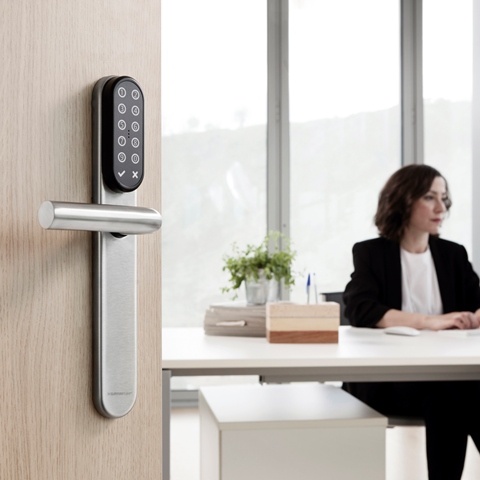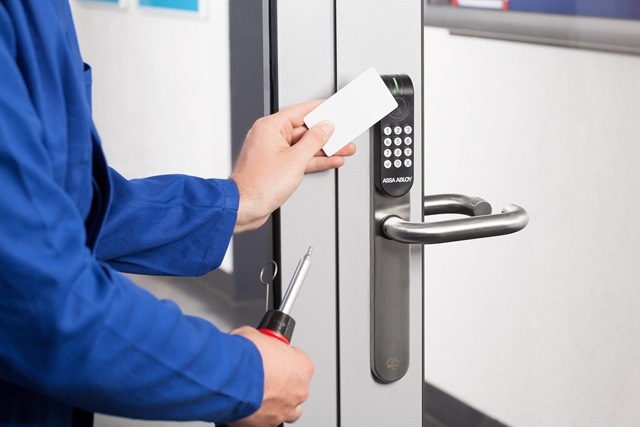Market Data Suggests Access Control is Going Even More Wireless
Customer research points to continued strong growth for wireless locking solutions, as Thomas Schulz, Marketing and Communications Director, Digital and Access Solutions, at Assa A...




Customer research points to continued strong growth for wireless locking solutions, as Thomas Schulz, Marketing and Communications Director, Digital and Access Solutions, at Assa Abloy EMEA explains.
As a major player in door opening solutions, Assa Abloy is always able to survey a large, representative segment of the professional security market. We did so recently, seeking insights into how the market for access control is changing. What we found is that it is evolving, and fast. Comparing our latest data with research we carried out in 2014 shows an obvious trend: our 2014 survey found that 23% of commercial properties were using a wireless or hybrid wired/wireless access system. By 2016 that had risen to 29%, with 5% of premises already equipped with a totally wireless solution. That’s a significant leap in a short time. We published these (and other) findings in a free report entitled “The Wireless Access Control Market in 2016.
Already, 69% of our respondents considered wireless locks to be a cost-effective alternative to wired access control. And 62% even predicted few business premises would still have mechanical locks within a decade. But why are companies making the switch to wireless?
Cost-efficiency, easy installation and compliance requirements for audit trails are often mentioned. Everything about wireless access control makes life easier for those who install or operate it. It’s easy to extend an existing third-party access control system by switching mechanical locking cylinders for battery-powered, electronic Aperio cylinders, for example. You can incorporate them into the existing control panel via communications hubs (online integration) or via update-on-card (offline). Compare that to the wholesale rewiring needed to add more wired electro-magnetic locks.
Instant Security Increase
Swapping mechanical locks for electronic access control upgrades a door’s security in an instant. Smart cards eliminate key management headaches as well as security risks posed by any lost mechanical key – an all too common occurrence, and something that 86% of survey respondents also worried about.
Easy, effective integration of wireless lock technologies – like Aperio - with complementary CCTV, alarm, HVAC and other building management systems is another major benefit. “Wireless locks are often specially designed for integration with other systems. The integration capabilities and ease of use can be a significant benefit,” writes Blake Kozak, a principal analyst at IHS Research, in a commentary on our publication.
Among our own product portfolio, Aperio wireless locks integrate with almost any leading security system, allowing facilities staff to bring access control much further into a site than would be possible with traditional access control. At i2 serviced offices around the UK, for example, Aperio locks replaced the slow and expensive job of hardwiring every newly sublet office into i2’s central access control system. Facility managers can now amend access rights remotely, instantly cancel lost keys or extend an existing access control system without disruptive structural alterations.
Typical Installations
Aperio is the access control backbone at Ghent’s Maria Middelares Hospital. It also enables real-time management at a new residential care home in Umeå, Sweden. Sensitive settings like these need the real-time information flow that only electronic access control can provide. In the event of a security breach at a medicine store or patient records room, wireless locks can generate detailed audit trails for locks, users or keycards.
Mains Unnecessary
Another Assa Abloy technology, Cliq, is a wireless, mechatronic locking system based on patented, high-security cylinders, battery-powered programmable keys and encrypted electronic communications. Its proven security credentials and the ability for in-house managers to issue contractors with programmable keys both assist workflow management in complex organization structures.
It is widely adopted in critical infrastructure settings around Europe. Such sites are often widely dispersed or remote (and often both). Cliq locks don’t need a mains electricity connection, making them a perfect choice for reservoir pumping stations, electricity sub-stations and power generation or distribution facilities. Certified locks and encrypted communications between lock and system ensure stringent security criteria are met. In Helsinki, Finland, Cliq secures 3,500 interior and exterior doors at 70 different sites for Helsingin Energia, helping to ensure that 400,000 customers have an uninterrupted electricity supply. The whole ecosystem is managed remotely from simple, web-based Cliq administration software. Industrielle Werke Basel needed a locking system that would equip it to face 21st century security challenges, as well as padlocks that could withstand extremes of climate and weather. Cliq delivered.
Going Greener
Smartair is a separate stand-alone wireless locking system suitable for small to medium-sized premises such as offices, small hotels, nursing homes, schools and universities. Building managers at Frankfurt’s Tower 185 chose Smartair for its easy installation and access rights processing speed. Because Smartair locks are wireless, they consume less energy and result in lower CO2 emissions than wired magnetic locks. It’s no coincidence that Tower 185 was among the first European high-rises awarded Gold LEED Certification by the US Green Building Council. The flexibility of Smartair was a major factor in the Red Cross’s decision to select it for their new Córdoba headquarters.
Growth Market
Interestingly, our research also finds customers already considering wireless deployments beyond just doors. Well over half of respondents judged electronic access control well suited to securing server racks, cabinets, lockers, safes and machines, as well as padlocked outdoor structures. Flexibility makes wireless technology the natural solution.
“Interior doors, filing cabinets, carts and other deployments will increasingly use wireless electronic systems,” says Kozak. “In deployments beyond doors, IHS expects mechatronic locks to see the most growth. Globally, we forecast that these devices will see volume growth of about 24% in 2016 as security personnel strengthen security to adhere to strict compliance regulations, which often require audit trails. Mechanical keys simply don’t offer this level of tracking.” With audit trail compliance, easy installation, cost efficiency and seamless integration, wireless access control makes life easier for security managers, installers and system integrators. This is the secret to its rapid growth, and the reason for its widespread adoption across many business sectors.
most read

GIT SECURITY AWARD 2026 - The winners have been announced!
GIT SECURITY AWARD 2026: The best safety and security solutions of the year - now an overview of all winners

When the Internet stumbles: Why DNS is important
When DNS fails, the internet stumbles-AWS outage proves resilience and redundancy are vital for digital trust


Security management, building security & perimeter protection: the winners of category E at the GIT SECURITY AWARD 2026
GIT SECURITY AWARD 2026: Security management, building security & perimeter protection - an overview of the most innovative solutions

Is Your Venue Ready for Martyn’s Law?
Martyn’s Law demands stronger security by 2027. Is your venue prepared to protect and respond?









